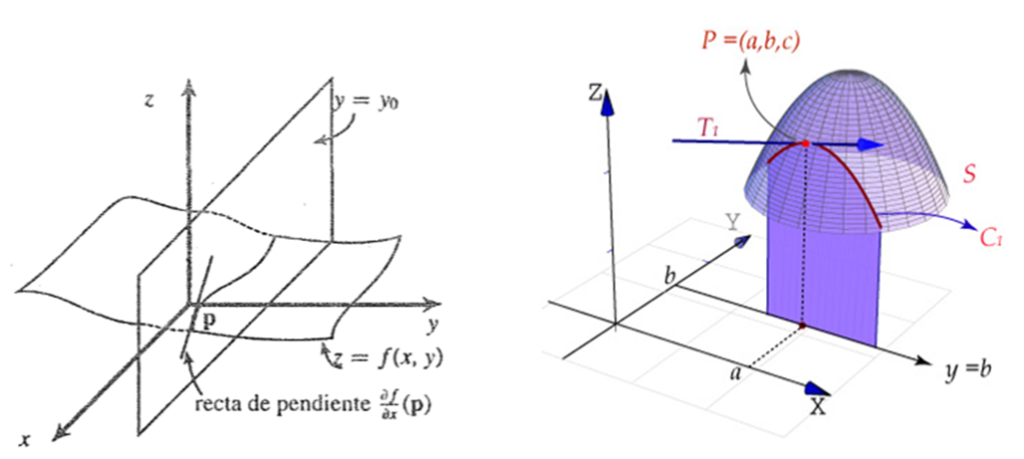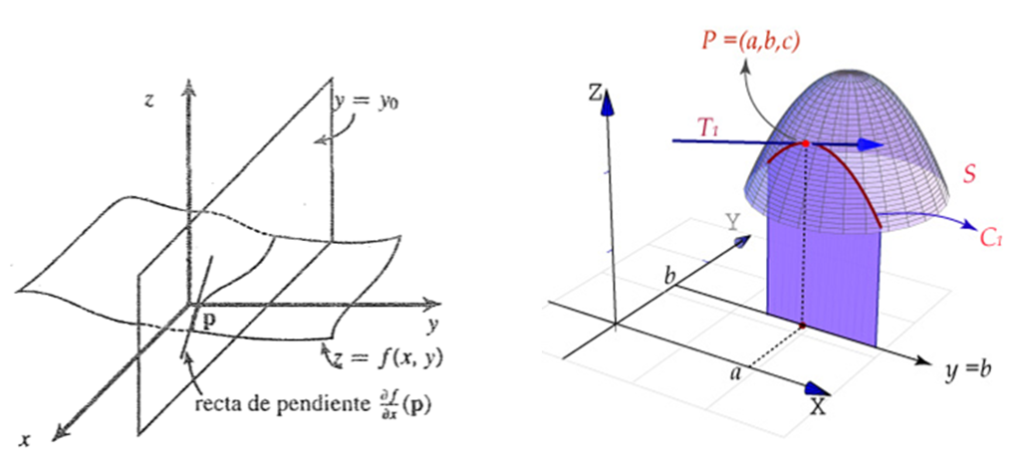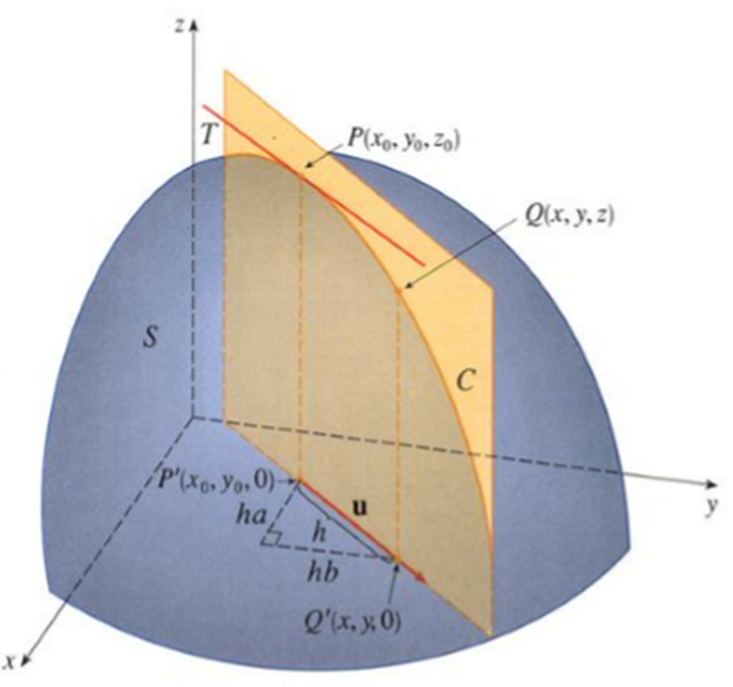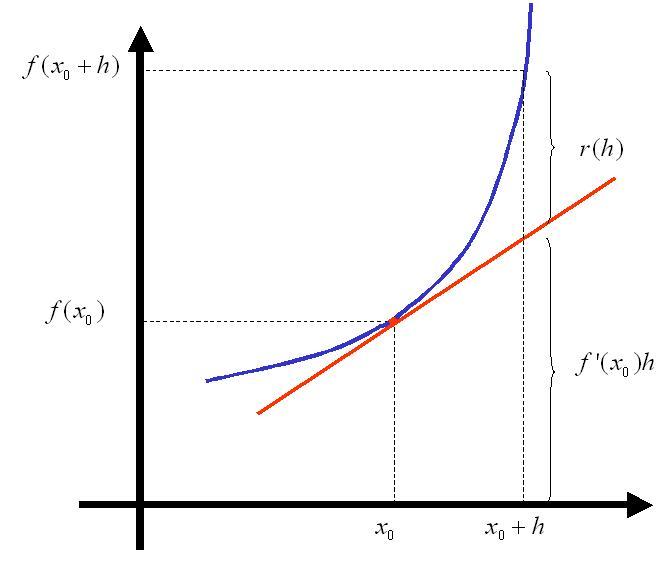Diferenciación de funciones $\mathbb{R}^{n}\rightarrow\mathbb{R}$
Sea $f:A \subseteq\mathbb{R}^{n}\rightarrow \mathbb{R}$ y $\overline{a}=(a_{1},\ldots,a_{n}) \epsilon {A}$. Se define la derivada pacial $i$-esima en $\overline{a}$ denotada $f_{x}(\overline{a})$, $D_{x}f(\bar{a})$ ó $\displaystyle\frac{\partial f}{\partial x}(\bar{a})$ de la forma $f_{x}=\displaystyle\lim_{h \rightarrow 0}\frac{f(a_{1},\ldots,a_{i}+h,\ldots.a_{n})-f(\bar{a})}{h}=\displaystyle\lim_{h \rightarrow 0}\frac{f(a+he_{i})-f(a)}{h}$ siendo
$\bar{e}_{i}=(0,\ldots,\underset{i-esimo}{1},\ldots,0)$. Si $n=2$ existen 2 derivadas parciales.
Sea $\bar{a}=(x_{0},y_{0})$ un punto del interior del dominio de $f:A \subseteq\mathbb{R}^{2}\rightarrow \mathbb{R}$ las derivas parciales de $f$ en el punto $\bar{a}$ denotada respectivamente por $f_{x}(x_{0},y_{0})$, $f_{y}(x_{0},y_{0})$
son:
$$f_{x}(x_{0},y_{0})=\displaystyle\lim_{h \rightarrow 0}\frac{f(x_{0}+h,y_{0})-f(x_{0},y_{0})}{h}$$
$$f_{y}(x_{0},y_{0})=\displaystyle\lim_{k \rightarrow 0}\frac{f(x_{0},y_{0}+k)-f(x_{0},y_{0})}{k}$$
Sea $f:I\subset\mathbb{R}^{2}\rightarrow\mathbb{R}$ dada por $f(x,y)=x^{2}y^{3}$
Calcular $f_{x},~f_{y}$
En este caso
$$f_{x}=\lim_{h\rightarrow 0}\frac{f(x+h,y)-f(x,y)}{h}$$
$$=\lim_{h\rightarrow 0}\frac{(x+h)^{2}y^{3}-x^{2}y^{3}}{h}$$
$$=\lim_{h\rightarrow 0}2xy^{3}+hy^{3}=2xy^{3}$$
$$f_{y}=\lim_{h\rightarrow 0}\frac{f(x,y+h)-f(x,y)}{h}$$
$$=\lim_{h\rightarrow 0}\frac{x^{2}(y+h)^{3}-x^{2}y^{3}}{h}$$
$$=\lim_{h\rightarrow 0}3x^{2}y^{2}+hy^{3}$$
$$=3x^{2}y^{2}$$
Ejemplo. Sea

Calculemos $f_{x}(0,0)$
$$f_{x}(0,0)=\lim_{h\rightarrow 0}\frac{f(0+h,0)-f(0,0)}{h}$$
$$=\lim_{h\rightarrow 0}\frac{\frac{h(0)}{h^{2}}}{h}$$
$$=\lim_{h\rightarrow 0}\frac{0}{h^{3}}=0$$
$$f_{y}(0,0)=\lim_{h\rightarrow 0}\frac{f(0,0+h)-f(0,0)}{h}$$
$$=\lim_{h\rightarrow 0}\frac{\frac{(0)h}{h^{2}}}{h}$$
$$=\lim_{h\rightarrow 0}\frac{0}{h^{3}}=0$$
En este caso $f_{x}=0=f_{y}$ sin embargo la función no es continua
Derivada Direccional en un punto
Sea $f:A\subseteq\mathbb{R}^{n}\rightarrow \mathbb{R}$ $x_{0}\in A$. Sea $u\in \mathbb{R}^{n}$ con $|u|=1$ la derivada direcional de $f$ en
la dirección del vector $u$, en el punto $x_{0}$ denotada por $\displaystyle{\frac{\partial f}{\partial u}}(x_{0})$, se define por
$$\displaystyle{\frac{\partial f}{\partial u}}(x_{0})=\displaystyle\lim_{h \rightarrow
0}\frac{f(x_{0}+hu)-f(x_{0})}{h}$$
Ejemplo. Sea $f(x,y)=x^{2}y$ y sea $\displaystyle{u=\left(\frac{1}{\sqrt{5}},\frac{2}{\sqrt{5}}\right)}$ por lo tanto la derivada direccional en $(x_{0},y_{0})$ es:
$$\lim_{h \rightarrow0}\frac{f\left((x_{0},y_{0})+h\left(\frac{1}{\sqrt{5}},\frac{2}{\sqrt{5}}\right)\right)-f(x_{0},y_{0})}{h}=\lim_{h \rightarrow0}\frac{\left(x_{0}+\frac{h}{\sqrt{5}}\right)^{2}\left(y_{0}+\frac{2h}{\sqrt{5}}\right)-x_{0}^{2}y_{0}}{h}=$$
$$\lim_{h \rightarrow0}\frac{\left(x_{0}^{2}+\frac{2x_{0}h}{\sqrt{5}}+\frac{h^{2}}{5}\right)\left(y_{0}+\frac{2h}{\sqrt{5}}\right)-x_{0}^{2}y_{0}}{h}=\frac{2x_{0}^{2}}{\sqrt{5}}+\frac{2x_{0}y_{0}}{\sqrt{5}}$$
Notas: 1) La derivada direccional indica la variación de la función en la dirección de $\bar{u}$.
2)Las derivadas parciales son derivadas direccionales respecto a los vectores de la base canonica.
Diferenciabilidad
$\textbf{Idea Geometrica}$
$y=f'(x_{0})(x-x_{0})+f(x_{0})$
si $x=x_{0}$
$y=f(x_{0})$
si $x=x_{0}+h$
$y=f'(x_{0})h$
$\therefore$ \qquad $r(h)=f(x_{0}+h)-f(x_{0})-f'(x_{0})h \qquad$ (Diferencial)
donde
$$\frac{r(h)}{h}=\frac{f(x_{0}+h)-f(x_{0})}{h}-f'(x_{0})$$
Debería ocurrir
$$\lim_{h\rightarrow 0}\frac{r(h)}{h}=0$$
Definición. Sea $A\subset\mathbb{R}^{2}$, un abierto, $f:A\rightarrow\mathbb{R}$ y $(x_{0},y_{0})\in A$. Se dice que f es diferenciable en $(x_{0},y_{0})$ si existen constantes $A_{1},~~A_{2}$ tal que
$$f((x_{0},y_{0})+(h_{1},h_{2}))=f(x_{0},y_{0})+A_{1}h_{1}+A_{2}h_{2}+r(h_{1},h_{2})$$donde
$$\lim_{(h_{1},h_{2})\rightarrow(0,0)}\frac{r(h_{1},h_{2})}{|(h_{1},h_{2})|}=0$$
En la definición anterior si se toma $h=(h_{1},0)$ se tiene
$$f((x_{0},y_{0})+(h_{1},0))=f(x_{0},y_{0})+A_{1}h_{1}+A_{2}(0)+r(h_{1},0)$$donde
$$\lim_{h_{1}\rightarrow0}\frac{f(x_{0}+h_{1},y_{0})-f(x_{0},y_{0})}{h_{1}}-A_{1}=\lim_{h_{1}\rightarrow0}\frac{r(h_{1},0)}{h_{1}}$$
como
$$\lim_{h_{1}\rightarrow0}\frac{r(h_{1},0)}{h_{1}}=0$$se tiene
$$\lim_{h_{1}\rightarrow0}\frac{f(x_{0}+h_{1},y_{0})-f(x_{0},y_{0})}{h_{1}}-A_{1}=0$$
en consecuencia
$$\frac{\partial f}{\partial x}=\lim_{h_{1}\rightarrow0}\frac{f(x_{0}+h_{1},y_{0})-f(x_{0},y_{0})}{h_{1}}=A_{1}$$
En la definición anterior si se toma $h=(0,h_{2})$ se tiene
$$f((x_{0},y_{0})+(0,h_{2}))=f(x_{0},y_{0})+A_{1}(0)+A_{2}h_{2}+r(0,h_{2})$$donde
$$\lim_{h_{2}\rightarrow0}\frac{f(x_{0},y_{0}+h_{2})-f(x_{0},y_{0})}{h_{2}}-A_{2}=\lim_{h_{2}\rightarrow0}\frac{r(0,h_{2})}{h_{2}}$$
como
$$\lim_{h_{2}\rightarrow0}\frac{r(0,h_{2})}{h_{2}}=0$$se tiene
$$\lim_{h_{0}\rightarrow0}\frac{f(x_{0},y_{0}+h_{2})-f(x_{0},y_{0})}{h_{2}}-A_{2}=0$$
en consecuencia
$$\frac{\partial f}{\partial y}=\lim_{h_{2}\rightarrow0}\frac{f(x_{0},y_{0}+h_{2})-f(x_{0},y_{0})}{h_{2}}=A_{2}$$
Definición. Sea $A\subset\mathbb{R}^{2}$, un abierto, $f:A\rightarrow\mathbb{R}$ y $(x_{0},y_{0})\in A$. Se dice que f es diferenciable en $(x_{0},y_{0})$ si existen las derivadas parciales $\displaystyle{\frac{\partial f}{\partial x}(x_{0},y_{0}),~~\frac{\partial f}{\partial y}}(x_{0},y_{0})$ tal que
$$f((x_{0},y_{0})+(h_{1},h_{2}))=f(x_{0},y_{0})+\frac{\partial f}{\partial x}(x_{0},y_{0})h_{1}+\frac{\partial f}{\partial y}(x_{0},y_{0})h_{2}+r(h_{1},h_{2})$$donde
$$\lim_{(h_{1},h_{2})\rightarrow(0,0)}\frac{r(h_{1},h_{2})}{|(h_{1},h_{2})|}=0$$
Más adelante
Veremos los resultados que caracterizan la derivabilidad de funciones reales en un punto.
Tarea Moral
1.- Si $f(x,y)=x^2y+y^3$, hallar $\displaystyle{\frac{\partial f}{\partial x}}$ y $\displaystyle{\frac{\partial f}{\partial y}}$
2.-Si $z=cosxy+xcosy=f(x,y)$ hallar las derivadas parciales $\displaystyle{\frac{\partial z}{\partial x}}(x_{0}, y_{0})$, $\displaystyle{\frac{\partial z}{\partial y}}(x_{0}, y_{0})$
3.- Evaluar las derivadas parciales $\displaystyle{\dfrac{\partial z }{\partial x}}$, $\displaystyle{\dfrac{\partial z}{\partial y}}$ para las funciones dadas en los puntos indicados.
a) $z=\sqrt{a^2-x^2-y^2}$, $(0,0)$, $(a/2,a/2)$
b) $z=log\sqrt{1+xy}$, $(1,2)$, $(0,0)$
4.-Hallar las derivadas parciales $\dfrac{\partial z}{\partial x}, \dfrac{\partial w}{\partial y}$
$z=e^{\alpha x}cos(bx+y); (2\pi/b,0)$
5.-Hallar $\dfrac{\partial f}{\partial x}$, $\dfrac{\partial f}{\partial y}$
$f(x,y)=(x^2+y^2)log(x^2+y^2)$




